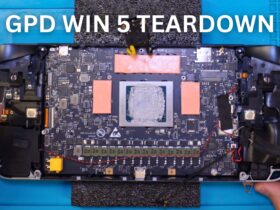Sveiki atvykę į mūsų vadovą apie tai, kas, mūsų manymu, yra geriausia šiuo metu prieinama RG350 pasirinktinė programinė įranga. Jame aprašysime, ką reikia daryti, kad ją įdiegtumėte savo sistemoje. Norite atgaivinti savo seną retro delninį kompiuterį? Skaitykite toliau ir sužinokite…
Kodėl Adam yra geriausia RG350 pasirinktinė programinė įranga?
Dažna problema, su kuria susidūrė žmonės, naudodami antrosios kartos ANBERNIC delninius kompiuterius, yra tai, kad sąsaja buvo labai paprasta. Nors ji nebuvo sudėtinga, bendras išdėstymas gąsdino mažiau patyrusius naudotojus, o net ir patyrusiems naudotojams ja naudotis buvo šiek tiek nepatogu.
ADAM vaizdas - tai bandymas pritaikyti patogų „EmulationStation" pagrįsto RG351 šeimos vaizdo dizainą senesnės serijos įrenginiams. Tai apima labiau grafinę sąsają ir net viršelio paveikslėlį per „SimpleMenu GUI".
Be to, šiame paveikslėlyje yra daugybė iš anksto įdiegtų emuliatorių, kurių nebuvo atsarginėje programinėje įrangoje, įskaitant dažnai prašomą „Sega AMIGA".
Atsakomybės apribojimas: Į šį atvaizdą neįkelta jokių žaidimų ar papildomų BIOS failų. Nors mes, „DroiX", esame dideli žaidimų išsaugojimo ir emuliacijos šalininkai, nepritariame ir nerekomenduojame neteisėtai dalytis autorių teisėmis apsaugotu turiniu.
Jums reikės:
- Žinoma, delninis kompiuteris! Adomo atvaizdas suderinamas su šiais prietaisais:
- ADAM programinės įrangos atvaizdas. Tai bus .img.xz atvaizdas, kurį galite atsisiųsti iš oficialios „github" saugyklos.
- Čia taip pat atsisiuntėme ir atspindėjome 1.3 versijos atsisiuntimą.
- Vaizdų rašymo programinė įranga. Mums labiau patinka „Win32 Disk Imager" arba " Rufus". Šiame vadove naudosime „Rufus".
- Nedidelė „microSD" kortelė operacinei sistemai (rekomenduojame mažiausiai 4 GB)
- Didesnė SD kortelė visiems žaidimams
1 veiksmas - nuvalykite „microSD" kortelę
Prieš tęsiant labai patartina visiškai ištrinti SD kortelę. Geriausias būdas tai padaryti - ją suformatuoti.
Jei norite sužinoti, kaip suformatuoti microSD kortelę, kad ją būtų galima naudoti, žr. šį ANBERNIC perinstaliavimo vadovo skyrių.
Dabar, kai kortelę suformatavote arba jei ji jau buvo tuščia, galite pereiti prie kito skyriaus.
2 žingsnis - Įrašykite vaizdą
Norėdami įrašyti atvaizdą į „microSD" kortelę, turėsite naudoti blykstės programinę įrangą, pavyzdžiui, " Rufus" arba „Win32 Disk Imager".
Darome prielaidą, kad jau atsisiuntėte ir įdiegėte „Rufus" ir jau atsisiuntėte ADAM atvaizdo failą. Dukart spustelėkite „Rufus" vykdomąjį failą ir pamatysite tokį langą, koks parodytas paveikslėlyje dešinėje.
Pirmiausia skyriuje „Įrenginys" įsitikinkite, kad pasirinkta „microSD" kortelė, kurią mirksite.
Antra, spustelėkite mygtuką „SELECT" (pasirinkti) ir pereikite prie atsisiųsto paveikslėlio „Adam". Pasirinkite jį.
Galiausiai, kai viskas bus paruošta, spustelėkite mygtuką START. Mirksėjimas bus pradėtas automatiškai. Neatjunkite „microSD" kortelės ir neuždarykite programos „Rufus", kol viskas nebaigta.

Dabar turėtumėte turėti „microSD" kortelę su dviem skirsniais. Vienas FAT32, o kitas Ext4. Jei FAT32 skirsniui nebuvo automatiškai priskirta disko raidė, turėsite jam priskirti raidę.
3 veiksmas - paleiskite partijos failą
Įdiegus „microSD" kortelę, reikia atlikti dar vieną veiksmą, kad galėtumėte įrenginį įdėti į sistemą.

Nueikite į kortelės Fat32 skirsnį. Ten bus partijos failas pavadinimu „select_kernel.bat". Dukart spustelėkite jį, kad paleistumėte.
Paleidę ją, pamatysite komandinę eilutę, kurioje bus prašoma patvirtinti, kuriame įrenginyje bus naudojamas Adomo atvaizdas. Įveskite modelį atitinkantį numerį ir paspauskite klavišą ENTER.

Tada paketinis failas atliks tam tikras operacijas, o po to bus baigtas ir paprašyta jį uždaryti / išstumti kortelę.
Dabar jūsų „Adam" microSD kortelė yra paruošta naudoti jūsų prietaise. Tiesiog įdėkite ją ir galėsite veikti!
Esame tikri, kad po kurio laiko suprasite, kodėl tai yra geriausia RG350 pasirinktinė programinė įranga, kuri šiuo metu yra prieinama.
Jei norite išsamiau aprašyti Adomo funkcijas arba prisidėti prie jo kūrimo, apsilankykite „github" puslapyje!
DUK
Kur yra žaidimai?

Pirmą kartą paleidę sistemą, tikriausiai nematysite jokių žaidimų. Taip greičiausiai yra todėl, kad jūsų išorinė „microSD" kortelė neturi reikiamo išdėstymo.
Adam ieškos žaidimų išorinėje SD kortelėje, jei aplankų struktūra yra tokia:

Skirtingi aplankai atitinka skirtingas platformas, pvz., „COLECO" yra aplankas, į kurį turėtų būti sudėti visi jūsų „Colecovision" žaidimai.
Kaip gauti viršelio paveikslėlį?
Darant prielaidą, kad kortelė išdėstyta teisingai, po kiekviena konkrečia platforma turėtų būti aplankas „.previews". Jei jo nėra, galite jį sukurti.
Į šį aplanką įdėkite .png failą, kurio pavadinimas (be plėtinio) sutampa su žaidimo, kuriam norite jį pritaikyti, pavadinimu.
Pavyzdžiui, jei turite „Game Boy" žaidimą „MyGame", esantį taip:
roms/GB/MyGame.rom
Adomas darys prielaidą, kad peržiūros vaizdas yra taip:
roms/GB/.previews/MyGame.png
Jei pavyko, meniu bus rodoma jūsų peržiūra.
Kodėl neįsijungia mano žaidimas?
Taip gali nutikti dėl įvairių priežasčių, tačiau labiausiai tikėtina, kad neturite reikiamos BIOS. Ne kiekvienas emuliatorius reikalauja BIOS (kai kurie turi atvirkštinius ir (arba) savarankiškus sprendimus), tačiau nemaža dalis jų reikalauja.
Jei norite sužinoti, kokių BIOS failų reikia, apsilankykite „github" puslapyje.










